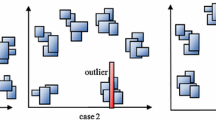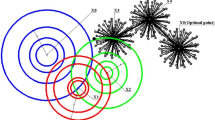Abstract
In this paper, following a partitioning around medoids approach, a fuzzy clustering model for interval-valued data, i.e., FCMd-ID, is introduced. Successively, for avoiding the disruptive effects of possible outlier interval-valued data in the clustering process, a robust fuzzy clustering model with a trimming rule, called Trimmed Fuzzy \(C\)-medoids for interval-valued data (TrFCMd-ID), is proposed. In order to show the good performances of the robust clustering model, a simulation study and two applications are provided.






Similar content being viewed by others
References
Anderson DT, Bezdek JC, Popescu M, Keller JM (2010) Comparing fuzzy, probabilistic, and possibilistic partitions. IEEE Trans Fuzzy Syst 18(5):906–918
Billard L, Diday E (2006) Symbolic data analysis: conceptual statistics and data mining. Wiley, England
Brown J, Broderick AJ, Lee N (2007) Word of mouth communication within online communities: conceptualizing the online social network. J Interact Mark 21(3):2–20
Campello RJGB (2007) A fuzzy extension of the Rand index and other related indexes for clustering and classification assessment. Pattern Recognit Lett 28(7):833–841
Campello RJGB, Hruschka ER (2006) A fuzzy extension of the silhouette width criterion for cluster analysis. Fuzzy Sets Syst 157(21):2858–2875
de Carvalho FdAT (2007) Fuzzy \(c\)-means clustering methods for symbolic interval data. Pattern Recognit Lett 28(4):423–437
de Carvalho FdAT, Tenório CP (2010) Fuzzy \(k\)-means clustering algorithms for interval-valued data based on adaptive quadratic distances. Fuzzy Sets Syst 161(23):2978–2999
de Carvalho FdAT, Csernel M, Lechevallier Y (2009) Clustering constrained symbolic data. Pattern Recognit Lett 30(11):1037–1045
de Souza RMCR, de Carvalho FdAT (2004) Clustering of interval data based on city-block distances. Pattern Recognit Lett 25(3):353–365
Cazes P, Chouakria A, Diday E, Schektrman Y (1997) Entension de l’analyse en composantes principales à des données de type intervalle. Revue Stat Appl 45(3):5–24
Coppi R, D’Urso P, Giordani P (2012) Fuzzy and possibilistic clustering for fuzzy data. Comput Stat Data Anal 56(4):915–927
D’Urso P, De Giovanni L (2011) Midpoint radius self-organizing maps for interval-valued data with telecommunications application. Appl Soft Comput 11(5):3877–3886
D’Urso P, Giordani P (2004) A least squares approach to principal component analysis for interval valued data. Chemom Intell Lab Syst 70(2):179–192
D’Urso P, Giordani P (2006a) A weighted fuzzy \(c\)-means clustering model for fuzzy data. Comput Stat Data Anal 50(6):1496–1523
D’Urso P, Giordani P (2006b) A robust fuzzy k-means clustering model for interval valued data. Comput Stat 21(2):251–269
D’Urso P, De Giovanni L, Massari R (2014) Self-organizing maps for imprecise data. Fuzzy Sets Syst 237(16):63–89
El-Sonbaty Y, Ismail MA (1998) Fuzzy clustering for symbolic data. IEEE Trans Fuzzy Syst 6(2):195–204
Everitt BS, Landau S, Leese M (2001) Cluster analysis, 4th edn. Arnold Press, London
Fu KS (1977) Syntactic pattern recognition, applications. Springer, New York
García-Escudero LA, Gordaliza A (1999) Robustness properties of k-means and trimmed k-means. J Am Stat Assoc 94(447):956–969
García-Escudero LA, Gordaliza A (2005) A proposal for robust curve clustering. J Classif 22(2):185–201
García-Escudero LA, Gordaliza A, Matrán C, Mayo-Iscar A (2010) A review of robust clustering methods. Adv Data Anal Classif 4(2):89–109
Gowda K, Ravi T (1995) Agglomerative clustering of symbolic objects using the concepts of both similarity and dissimilarity. Pattern Recognit Lett 16(6):647–652
Guru DS, Kiranagi BB, Nagabhushan P (2004) Multivalued type proximity measure and concept of mutual similarity value useful for clustering symbolic patterns. Pattern Recognit Lett 25(10):1203–1213
Heiser WJ, Groenen PJF (1997) Cluster differences scaling with a within-clusters loss component and a fuzzy successive approximation strategy to avoid local minima. Psychometrika 62(1):63–83
Ichino M, Yaguchi H (1994) Generalized Minkowski metrics for mixed feature-type data analysis. IEEE Trans Syst Man Cybern 24(4):698–708
Jeng JT, Chuang CC, Tseng CC, Juan CJ (2010) Robust interval competitive agglomeration clustering algorithm with outliers. Int J Fuzzy Syst 12(3):227–236
Kamdar T, Joshi A (2000) On creating adaptive Web servers using Weblog Mining. Technical Report TR-CS-00-05, Department of Computer Science and Electrical Engineering, University of Maryland, Baltimore County
Katona Z, Zubcsek PP, Sarvary M (2011) Network effects and personal influences: the diffusion of an online social network. J Mark Res 48(3):425–443
Kaufman L, Rousseeuw PJ (1987) Clustering by means of medoids. In: Dodge Y (ed) Statistical data analysis based on the L1-norm and related methods. North-Holland, Amsterdam, pp 405–416
Kaufman L, Rousseeuw PJ (1990) Finding groups in data: an introduction to cluster analysis. Wiley, New York
Kim J, Krishnapuram R, Davé R (1996) Application of the least trimmed squares technique to prototype-based clustering. Pattern Recognit Lett 17(6):633–641
Kohonen T (1989) Self-organization and associative memory, 3rd edn. Springer, New York
Krishnapuram R, Joshi A, Yi L (1999) A fuzzy relative of the k-medoids algorithm with application to web document and snippet clustering. In: IEEE international fuzzy systems conference (FUZZIEEE99), vol 3, IEEE, Seoul, pp 1281–1286
Krishnapuram R, Joshi A, Nasraoui O, Yi L (2001) Low-complexity fuzzy relational clustering algorithms for web mining. IEEE Trans Fuzzy Syst 9(4):595–607
Masson MH, Denœux T (2004) Clustering interval-valued proximity data using belief functions. Pattern Recognit Lett 25(2):163–171
McBratney AB, Moore AW (1985) Application of fuzzy sets to climatic classification. Agric For Meteorol 35(1):165–185
Palmer A, Koenig-Lewis N (2009) An experiential, social network-based approach to direct marketing. Direct Mark Int J 3(3):162–176
Qualman E (2012) Socialnomics: How social media transforms the way we live and do business. Wiley, New Jersey
Runkler T, Bezdek J (1999) Alternating cluster estimation: a new tool for clustering and function approximation. IEEE Trans Fuzzy Syst 7(4):377–393
Vinod HD (1969) Integer programming and the theory of grouping. J Am Stat Assoc 64(326):506–519
Webb Young J, Burgoyne B (2009) You’ve got a friend: measuring the value of brand friending on social networks. In: Market research study annual conference, Market Research Study
Wedel M, Kamakura WA (1998) Market segmentation: conceptual and methodological foundations. Kluwer Academic, Boston
Acknowledgments
The authors thank the editors and the three referees for their useful comments and suggestions which helped to improve the quality and presentation of this manuscript.
Author information
Authors and Affiliations
Corresponding author
Rights and permissions
About this article
Cite this article
D’Urso, P., De Giovanni, L. & Massari, R. Trimmed fuzzy clustering for interval-valued data. Adv Data Anal Classif 9, 21–40 (2015). https://doi.org/10.1007/s11634-014-0169-3
Received:
Revised:
Accepted:
Published:
Issue Date:
DOI: https://doi.org/10.1007/s11634-014-0169-3
Keywords
- Interval-valued data
- Partitioning around medoids
- Fuzzy clustering
- Robust clustering
- Trimming
- Web advertising




